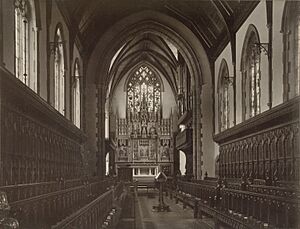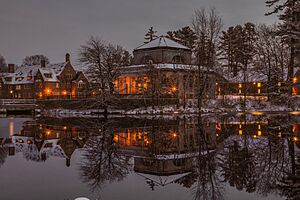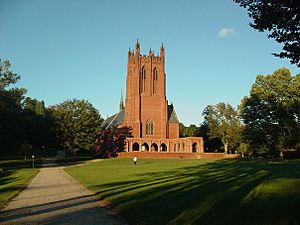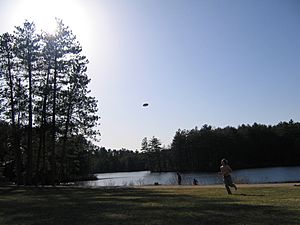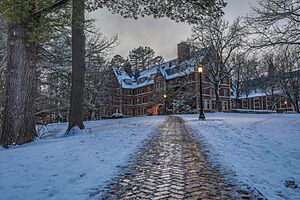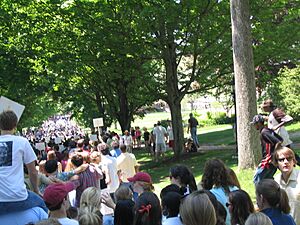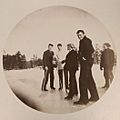St. Paul's School (New Hampshire) facts for kids
Quick facts for kids St. Paul's School |
|
|---|---|
 |
|
| Address | |
|
325 Pleasant St.
, 03301
United States
|
|
| Information | |
| Type | Private, boarding |
| Motto | Latin: Ea discamus in terris quorum scientia perseveret in coelis (Let us learn those things on Earth the knowledge of which continues in Heaven) |
| Religious affiliation(s) | Episcopal Church |
| Established | 1856 |
| Founder | George C. Shattuck |
| CEEB code | 300110 |
| Rector | Kathleen Carroll Giles |
| Faculty | 111 (2023-24) |
| Grades | 9 to 12 |
| Gender | Coeducational |
| Enrollment | 540 (2023-24) |
| International students | 22% (2023-24) |
| Student to teacher ratio | 5:1 (2023-24) |
| Campus size | 2,000 acres (809 ha) |
| Campus type | Suburban |
| Houses | 19 (9 boys', 9 girls', 1 all-gender) |
| Student council | StudCo (founded 1918) |
| Color(s) | Red & white |
| Song | "Love Divine" |
| Athletics | 51 interscholastic teams 17 interscholastic sports 8 intramural |
| Athletics conference | Lakes Region League |
| Mascot | Pelican |
| Nickname | Big Red |
| Accreditation | NEASC |
| Newspaper | The Pelican |
| Endowment | $759.3 million (June 2024) |
| Annual tuition | $68,353 (2024-25) |
| Affiliations | ESA NAES NAIS TABS TSAO |
| Acceptance rate | 13% (2024) |
| Faculty with advanced degrees | 77% (2023-24) |
| Students receiving financial aid | 38% |
St. Paul's School (also known as St. Paul's or SPS) is a private, coeducational boarding school in Concord, New Hampshire. It helps students get ready for college. The school is connected with the Episcopal Church.
St. Paul's has a large campus of 2,000 acres (about 8 square kilometers). It serves 540 students from 37 states and 28 countries. The school was started in 1856 for boys from wealthy families. Later, it became one of the first boys' boarding schools to welcome girls. Today, it has a diverse group of students from many different backgrounds.
St. Paul's is one of the few high schools in the United States that is only for boarding students. It has a large financial fund, called an endowment, of $759.3 million as of June 2024. This makes it one of the richest boarding schools in New England. Students from the U.S. whose families earn $150,000 or less per year can often get full tuition help. About 38% of students receive financial aid.
Contents
History of St. Paul's School
How St. Paul's Began
In 1856, a doctor from Boston named George Cheyne Shattuck started St. Paul's School. He turned his summer home in Millville, New Hampshire, into a boarding school for boys. Shattuck wanted his sons to learn in a quiet, natural setting. He also hoped the school would educate sons of other wealthy families from big cities.
For its first 50 years, two brothers, Henry Augustus Coit and Joseph Howland Coit, led St. Paul's. Henry Coit wanted St. Paul's to be like the famous English public schools. He brought in traditions like "forms" (grade levels) and religious services such as "evensong." The school's religious services were Anglo-Catholic, and at first, only Episcopalian students could attend.
St. Paul's quickly became popular with upper-class families. The school started with only three students but grew fast. By the mid-1860s, it was full. By 1895, it had 345 students.
Preparing Students for College
Samuel Drury became the head of the school in 1911 and stayed for 27 years. He made St. Paul's one of the best schools for getting into top universities like Harvard, Yale, and Princeton. At first, St. Paul's was not mainly a college-prep school. But Drury improved the school's academics. He hired better teachers, made school rules stricter, and improved student behavior.
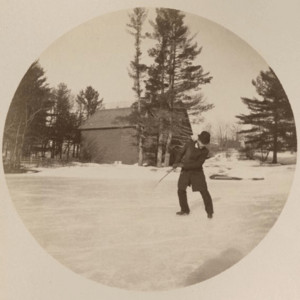
By 1934, 95% of St. Paul's graduates went to Harvard, Yale, or Princeton. Drury also wanted to make the student body more diverse and reduce snobbery among richer students. He set aside 10 spots each year for students who won a special test. He also raised money for student financial aid. From 1920 to 1938, the number of students on scholarships almost tripled.
Changes and Modernization
After World War II, the school continued to grow and change. Matthew Warren, who led the school from 1954 to 1970, oversaw many updates. Tuition increased, and the campus was greatly improved.
St. Paul's also became more open to different groups of students. The rule that only Episcopalians could attend was removed. The first Black faculty member joined in 1957, and the first Black student arrived in 1959. In 1971, St. Paul's began admitting girls, becoming a coeducational school.
William Oates, who became head in 1970, continued to make changes. He allowed students to have more say in school decisions. He also reduced the number of mandatory seated meals and changed the grading system to reduce competition. Oates also greatly expanded the arts program. He raised a lot of money, which doubled the school's endowment. This made St. Paul's the wealthiest boarding school in the U.S. per student.
In the 1990s, the school focused on improving its academic reputation. David Hicks, who was rector from 1992 to 1996, introduced a new humanities curriculum that is still used today. The school's academic standing improved significantly.
New buildings and facilities have been added over the years. The Ohrstrom Library opened in 1991, a large athletic center in 2004, and the Lindsay Center for Mathematics and Science in 2011. The school has faced a series of controversies in the 21st century.
Today, St. Paul's educates a diverse group of students from many backgrounds. It also continues to attract students from top families in America and around the world. In 2019, Kathleen Giles became the fourteenth rector of St. Paul's. She had previously led Middlesex School.
School Facilities
The school's campus is often called "Millville." It is named after an old mill that used to be there. When St. Paul's started, its campus was 50 acres. Today, it covers over 2,000 acres. Most of this land is undeveloped forests and wild areas. The campus also has four ponds and part of the Turkey River. In 2018, Architectural Digest magazine called St. Paul's the most beautiful private high school campus in New Hampshire.
The most important building on campus is the Chapel of St. Peter and St. Paul, also called the "New Chapel." It was built between 1886 and 1888. It was designed by Henry Vaughan, who also designed the Washington National Cathedral. The smaller Old Chapel, built in 1858, is still used for special events.
The Ohrstrom Library, which overlooks the Lower School Pond, was updated in 2016. It has 75,000 print books and almost half a million e-books. The Lindsay Center, the science and math building, has a greenhouse and an observatory. A new admissions center is planned to open in early 2025.
Dormitories
There are 19 dorms at St. Paul's: nine for boys, nine for girls, and one for all genders. Each dorm houses between 20 and 40 students. Students from all four grade levels live in every dorm. The dorm buildings have different styles, from the old-fashioned "Collegiate Gothic" of the Quad dorms to the more modern Kittredge building.
School Finances
Tuition and Financial Aid
For the 2024-25 school year, St. Paul's tuition is $68,353 plus other fees. Financial aid covers, on average, $60,500 of this cost.
St. Paul's offers financial aid based on a family's need. The school promises to meet 100% of the financial need for every student who is accepted. Families in the U.S. with yearly incomes of $150,000 or less usually qualify for full tuition support. About 38% of St. Paul's students receive financial aid. The school's budget for financial aid is about $12.6 million.
The school also offers a few special scholarships for students from certain states and Mexico.
Endowment and Expenses
As of June 30, 2024, St. Paul's has a financial fund (endowment) of $759.3 million. This means the school has about $1.4 million for each student. This large endowment helps the school provide excellent programs and financial aid.
St. Paul's has historically been one of the wealthiest boarding schools in the United States. This wealth helps the school maintain its facilities and offer many opportunities to its students.
Admissions and Student Body
Admissions Process
In 2024, St. Paul's welcomed 141 new students. The school accepted 13% of all applicants. These new students came from 24 states and 22 countries. Based on 2023 data, 71.7% of students who were accepted chose to attend St. Paul's.
Student Diversity
For the 2023-24 school year, 48% of St. Paul's students identified as people of color. Also, 22% of the students were international students. The student body represents 37 states and 28 countries, showing a wide range of backgrounds.
Athletics at St. Paul's
Popular Sports
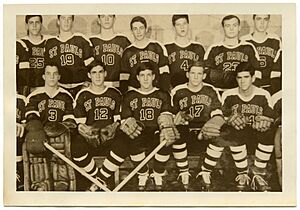
George Shattuck, the school's founder, believed in outdoor education and physical activity. St. Paul's was one of the first schools to focus on physical development.
St. Paul's has a long history with ice hockey. The school and the city of Concord were important places for early hockey in America.
- Some say the first hockey game in the United States was played on St. Paul's Lower School Pond on November 17, 1883. This happened after a teacher, James Potter Conover, saw the game played in Montreal.
- In 1885, America's first written hockey rules were created at St. Paul's by a student named Malcolm Gordon. He later coached hockey at SPS and is in the U.S. Hockey Hall of Fame.
- St. Paul's was a strong force in early 20th-century American hockey. Its teams played against and beat college teams like Harvard and Princeton.
- The award for the best male college hockey player, the Hobey Baker Award, is named after SPS alumnus Hobey Baker.
The first squash courts in the United States were built at St. Paul's in 1884. James Potter Conover also brought an early version of squash to the school.
The St. Paul's boys' and girls' rowing teams have won many international titles. The boys' team won the Princess Elizabeth Challenge Cup at the Henley Royal Regatta in 1980, 1994, and 2004. The girls' team won the Peabody Cup at the Henley Women's Regatta in 1996, 1998, 2001, and 2019.
Sports Leagues
St. Paul's is part of the Lakes Region League, a sports conference for prep schools in New Hampshire and Vermont. The athletic directors of St. Paul's and other schools in the Eight Schools Association also work together to organize sports events and tournaments.
Daily Life at St. Paul's
St. Paul's uses the Harkness method for its Humanities classes. This method encourages students and teachers to have open discussions around a table.
Student Life and Learning
According to sociologist Shamus Khan, an alumnus of St. Paul's, students learn how to be leaders and contribute to society. The school's amazing financial resources allow it to bring together a diverse group of students. Students who receive financial aid get a large discount on tuition.
The school has traditions and rituals that help students grow and learn.
School Traditions
The annual Inter-House Inter-Club Race, now called the "Charles B. Morgan Run," happens in the fall. Students run a 2-mile (3.2 km) cross country race to earn points for their dorm and club.
In the spring, St. Paul's holds a public speaking contest called the Hugh Camp Cup. The finalists give their speeches to the whole school, and students vote for a winner. Alumnus John Kerry won this award when he was a student.
St. Paul's students have enjoyed music from various artists. The band Phish played in the Upper Dining Hall in 1990. Electronic music artist Steve Aoki performed at the school's Athletic & Fitness Center in 2015.
Advanced Studies Program
St. Paul's School started the summer Advanced Studies Program in 1957. This program offers challenging learning opportunities for high school juniors from public and private schools in New Hampshire. Students live and study on the St. Paul's campus for five and a half weeks. They focus on a subject of their choice, like astronomy or Shakespeare. Besides their classes, students also choose a daily activity or sport. In 2014, 267 students from 78 high schools took part in this program.
Notable Alumni
Notable Faculty
- James Milnor Coit, teacher
- George A. Gordon, United States Ambassador to Haiti and the Netherlands
- Richard Lederer, English teacher and author
- Gerry Studds, who later served as a U.S. congressman
- John T. Walker, the first African-American Episcopal bishop of Washington, D.C.
- John Gilbert Winant, governor of New Hampshire and ambassador to Great Britain during World War II
See also
- Boarding school
- College-preparatory school
- Saint Grottlesex, a common name for several prep schools in the area
Images for kids


